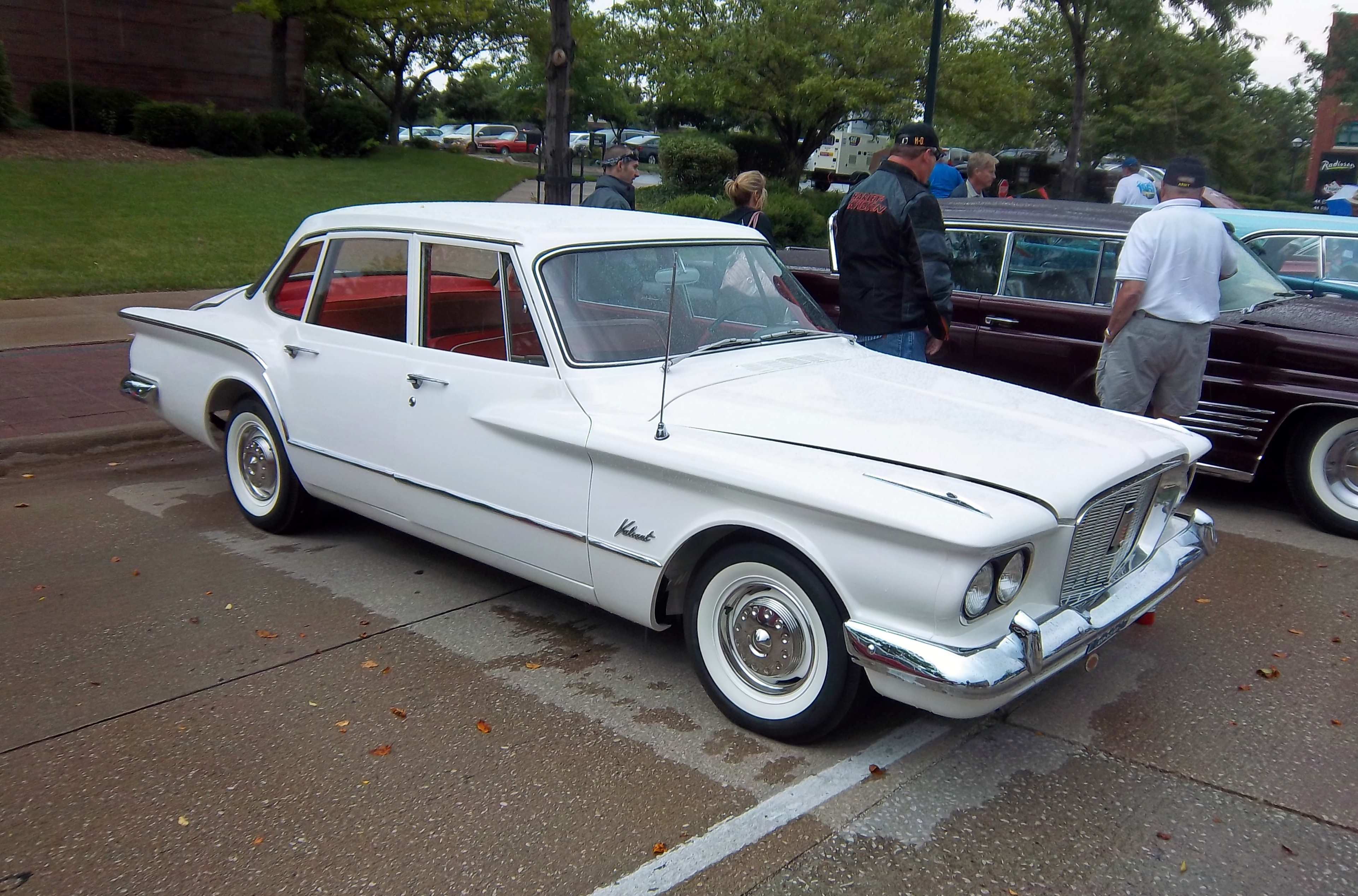
Valiant. Speak the name to anyone who grew up in the Sixties and it will almost certainly prompt a ton of memories, both good and bad: “Oh, my Aunt Becky and Uncle Sid had one, it was the toughest car they ever had!” Or, “I drove one in high school, got it for $100 off a shady used car lot and it was the dullest, slowest car I ever owned!” In approximately 95% of these circumstances, these memories will be prefaced by the words Plymouth Valiant–and indeed, Valiants were Plymouths from 1961 through 1976–but not in its inaugural year in 1960. Yes, 1960, a Buck Rogers year for sure! It was also The Year Of The Compacts: Corvair, Falcon, and of course, Valiant.

Chrysler Corporation’s response to the mini-import boom of the late 1950s-chiefly led by the ubiquitous Volkswagen-was much more, um, stylish distinctive than the shrunken-full-size-Galaxie Ford Falcon and outré, VW-reminiscent, rear-engined Chevrolet Corvair. Virgil Exner was clearly the father of the Valiant, proven by its wild sheetmetal. From every angle, though, it was its own car-definitely not a Mini-Me Fury or Polara.

1960 Valiant-not a Plymouth until next year!
Of the three new Detroit compacts, it was also the hottest number. That lovely Slant Six engine–which made its debut in this car and would go in to wide acclaim well into the 1980s–got the Valiant up to speed in no time, especially when equipped with the Hyper-Pak engine option. Some Valiants even went racing.
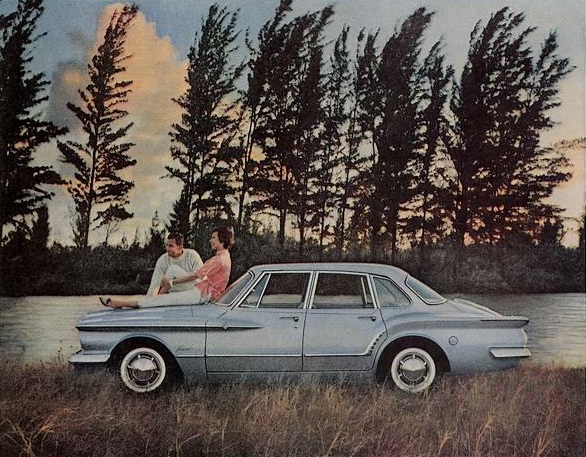
1961 Plymouth Valiant V-200 sedan
The 1960 Valiant was every bit a product of the Chrysler Corporation, with the unit construction shared with their bigger brethren, a torsion bar front suspension and optional push-button automatic. A floor-mounted three-speed stick was standard equipment. Valiants came in two flavors: V-100 and V-200.
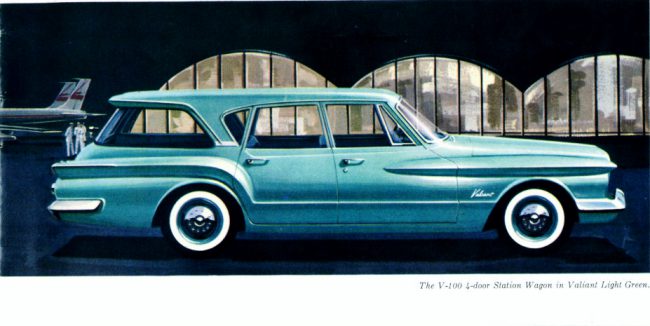
1961 Plymouth Valiant V-100 station wagon
The V-100 was the base model, also known as the cheapskate special, ha ha. With little chrome trim and a drab gray interior (shades of 2018-literally), but it still had that lovely, brand-new engine, crazy Exner styling (either a plus or a minus, depending on your point of view) and plenty of interior room.
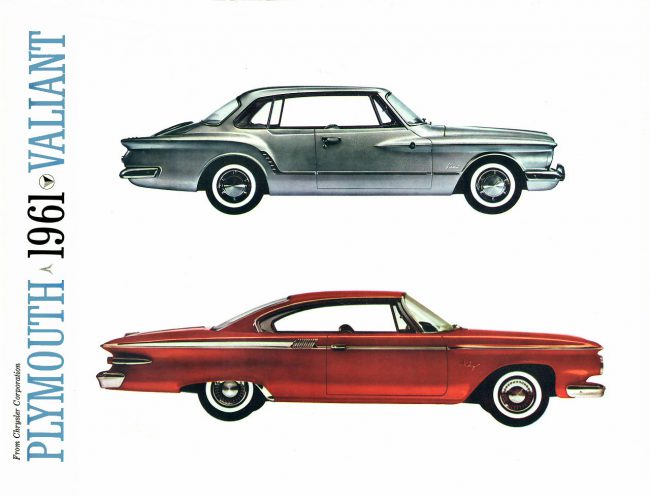
1961 Valiant two-door hardtop and 1961 Fury
At first only sedans were available. Later in the model year a station wagon was added, but no two doors were available until 1961. Even then, it was clearly derived from the four-door sedan, with the same roof panel.
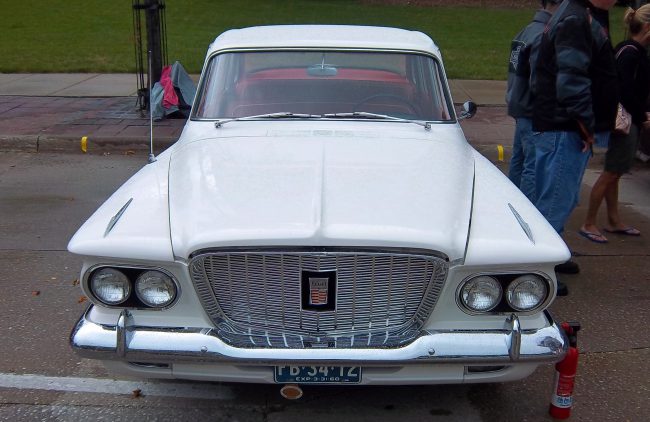
And just look at all that glass area. Yes, you used to be able to see things from the driver’s seat. What a concept. Today’s buyers seem to crave mini-loophole windows and combovers-oops, I mean crossovers. But I digress. Let’s get back to the subject at hand, shall we?
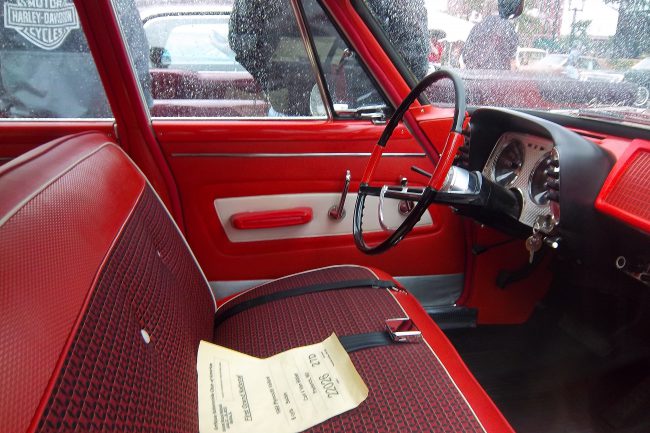
The finest Valiant money could buy was the uplevel V-200, which offered much nicer upholstery with vinyl bolsters and nylon inserts, in a choice of three colors. Two-tone door cards were also added. Outside, V-200s got bright side moldings that wrapped around the flared rear wheel arches, as well as bright window trim. A V-100 sedan started at $2,033, and the V-200 at $2,110.
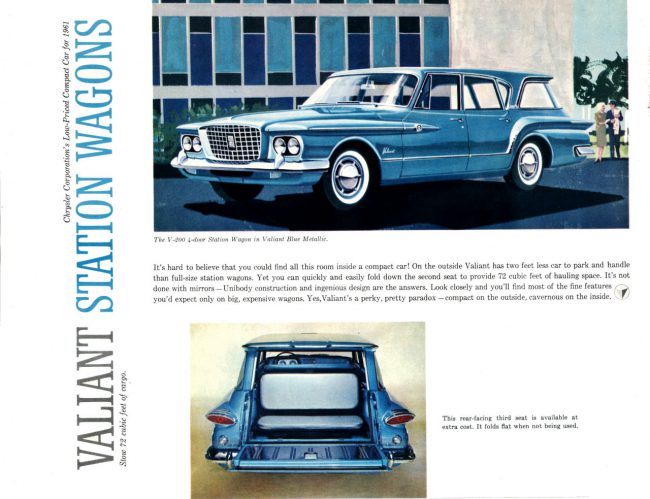
As mentioned earlier, soon after the sedans made their debut, V-100 and V-200 station wagons were added to the lineup. These little haulers arguably were even more eccentrically styled than the sedans; sadly, though, the Exner “toilet seat” fake spare tire trim was not available on the wagons, which were available as six-passenger V-100 and V-200 models and a nine-passenger V-200. The nine-seat wagon was the most expensive ’60 Valiant, at $2,546, and also the rarest: Just 4,675 were built. Try and find any 1960-62 Valiant wagon now! I’ve never seen one. And I go to a lot of car shows.
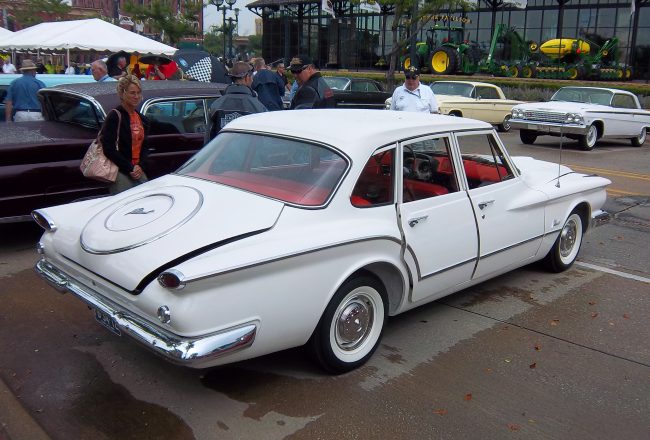
This pristine ’60 V-200, one of 106,515 built, was seen at the AACA Grand National meet held in Moline, IL in June 2013. Living ten minutes away from the event guaranteed my attendance. Despite rain that never entirely went away, I saw plenty of cool cars. This V-200 is the first 1960-62 Valiant I’ve ever seen in the metal. The styling is certainly polarizing, but I love ’em!
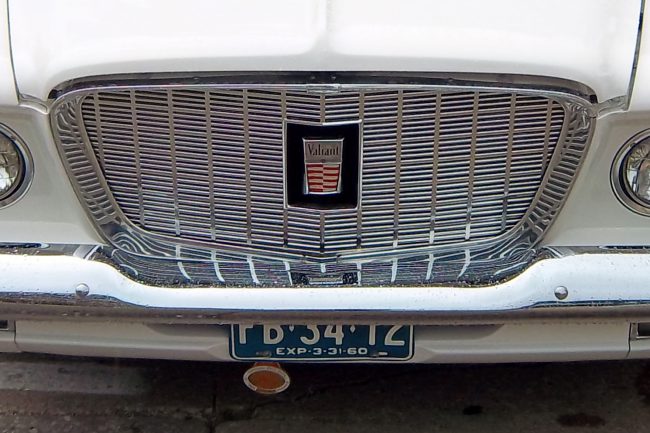
That race-car grille is a big plus to me. It was not until recently that I realized the Valiant badge on the grille did double duty as a hood release. Functional and attractive.
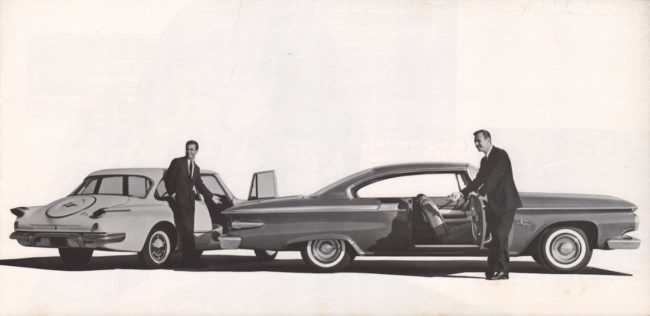
The Valiant stood alone in 1960–but for that year only. In 1961, it officially became a Plymouth. Plymouth needed the extra sales, as Dodge’s full-size, Plymouth-based 1960 Dart had led many Plymouth loyalists to abandon to purchase their family rival: While 1960 and 1961 were not good years for big-Plymouth sales, the Valiant was a bright spot, and would continue to be for years to come.
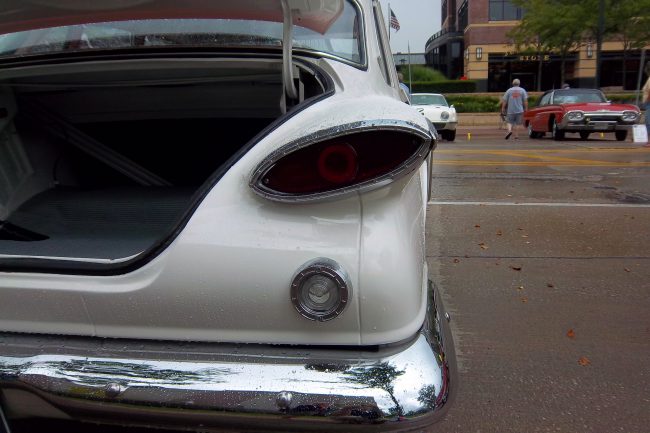







44 Comments
Harkens back memories. Someone at a place along my school-bus route…next door to a classmate…took a shine to Valiants of that era. Had four of them – a wagon, a two-door, and two four-doors. This being the late 1960s in Cleveland, they were not new and were not pristine.
Looking back, and thinking how rare that car was becoming even then, as buyers for the odd-looking thing were scarce…I suspect the owner was scooping up good examples cheap as he found them.
That car SHOULD have been a winner. It had the basics – a new, capable engine with basic design differences; TorqueFlite – and with push buttons! Room for occupants, something many compacts lacked.
All of that overlayed with Exner’s styling. Exner should have been fired for that, and probably was, partly…but someone at Chrysler should have cut it off, thrown his sketches in the trash, and farmed out the Valiant design. It didn’t need to be so boxy as later examples were…just toned down, some logic, some flow, some consistency in the overall design.
What is that plate, there? A 1960 Ohio plate?
I didn’t know they ever embossed expiration dates on them. I had had a collection of them from 1963 to the undated 1980s plates, and while in the 1960s, all registrations expired April 30, they never had expiration dates on them. Year embossed, yes – but not the date.
I believe that’s a Maryland plate.
The Chrysler slant six – I have the valve clatter imprinted on my brain every time I hear the name. They had solid lifters and apparently virtually no one ever did the periodic valve lash adjustment, so as they got older the clatter got louder, but they kept on running. Too bad Exner was in charge of the Valiant styling – a nice clean design like the Falcon or Corvair would have made it a top seller, because it is otherwise a far superior car to the awful Falcon, and a “safer” mainstream offering than the exotic Corvair (and Beetle). Yet today the few survivors wear that goofy Exner styling well, and your nice photographs of that well restored car really show it to its best effect.
Oh, gawd, that valve clatter.
In the early 1980s I was driving a taxi for an independent suburban company…the owner was wildly eccentric, as such people will be…but he was sold on Chrysler compacts. When I started he had a Dart and a Valiant (mid-1970s examples) in his fleet, along all the Volares and Aspens and Diplomats and Gran Furies (what an Iacocca-esque name, “Gran Fury”…)
They all had Slant Sixes. He was REALLY sold on those. As he scrapped his junker cabs, he’d disembowel them…sometimes he’d save the front clips (leading to some wild combinations of F and M bodies he’d kit-bash) but always, the Slant Six got saved and put on his parts rack.
Only the latest ones (I returned as a driver briefly in 1987) had hydraulic tappets. Took them 24 years to make up their minds to put them in, shortly before obsoleting the Slant Six entirely.
What a waste.
But, yeah, I remember the clatter of those tappets – that, and the Chrysler Reduction starter motor. By that time, the M bodies were the only ChryCo vehicles still using that starter system.
I realize you mention all the offerings from Detroit, but neglected to mention Studebakers Lark. Introduced for 1959, It showed that “compact” cars had a market with sales of around 130,000. Sales were also strong in 1960, but tanked in 1961 due to several factors, but mostly the introduction of compacts from the big 3.
The Lark is the classic example of “when life gives you Lemons, make Lemonade”, as it was simply the standard size (and very slow selling) Studebaker platform with the overhangs chopped off to make it a compact just in time for a US market growth spurt in “small” cars. Studebaker had no idea the compact market was coming (they only knew what they were currently doing wasn’t working), and they had no product development money, so they made the Lark on a shoestring and got lucky for once. Subaru did something similar in the 1990s when they didn’t have any money to create an SUV, so they jacked up their Legacy and called it an Outback, and instead of Mr. Ed as an endorser (Studebaker), they used Crocodile Dundee.
You’re of course right on the origins of the Lark; but yes, Studebaker DID know the compact market was coming. First, prior to the Lark, their throwaway model, the Scotsman, became a best-seller. That’s what told them there was a big market to be filled.
Then, they saw the Rambler rise in sales – along with the imports.
Finally…it’s not coinky-dink that the Valiant and the Lark got identical trapezoidal grilles. There was cross-pollination there…whether by theft or friendly exchange, we can’t know. But Studebaker had a jump on the market, for several reasons. First, desperation. Second, relatively low development – just Sawzall off the front and rear overhang of the Champion; and then a bit of a frame tuck behind the front seat.
So they were out the gate a year early; and that’s what saved Studebaker-Packard-Worthington, the corporation if not the auto division.
I will have to disagree that they knew the compact market was coming, because it was still very small until 1959 when the Lark was introduced. In 1958 VW had about 80% of the import market with just over 100,000 US sales, and Rambler compact sales were just over 100,000 – both big increases from 1956-57. This was when full-size Chevy and Ford sales were typically well over 1 million (each) annually, and upscale Cadillac was selling over 100,000 units annually. Nash thought the compact market was coming in 1949, but never sold more than 70,000 Rambler compacts until 1958. Kaiser and Hudson also hoped the compact market would come in the early 50s, but lost their shirts on the Henry J and Jet respectively. These US compacts from the independents were not actually cheaper than the base full-sizers from the Big 3, so the only reason people bought them was because they wanted the smaller size and better fuel economy as the full-sizers ballooned in the late 50s.
One thing that held Studebaker and Rambler back in sales was holding on to the flathead six for too long. In Studebakers case, the OHV six they finally came out with was not very good, as it became infamous for cracking heads. As the Interstate system came of age, the flathead didn’t have a prayer, around town it was adequate.
Disclosure; I own a 60 model Lark, 259 V8 factory 4bbl (rated at 195 hp from the factory), 3 on the tree w/overdrive. It’s quite adequate for 4 people, 5 if you’re friendly, 6 if you’re intimate with at least 2 of the occupants. It will comfortably cruise at 70 mph, and return about 19-20 mpg. You do need to plan to spend an extra 10-15 minutes at a gas stop, due to folks wanting to ask about the car. Most common question; “who made Studebakers?”
Cool car – offering a V-8 on the Lark gave them a nice power advantage over other compacts competitors until the arrival of the Olds and Buick with the aluminum 215 V-8. I don’t expect the 6 cylinder Lark offered any significant improvement in fuel economy vs your V-8, but they were a whole lot slower.
The real powerhouse Lark came in 63, with the availability of the R2 supercharged 289, and a couple of R3 Larks made. The R2’s are still competitive at the pure stock muscle car drags.
64 R3 Lark
I’ll now quit thread jacking.
Sorry Tom.
Those R2 and R3 Larks should get credit for creating the “modern” muscle car formula: put your most monster motor in your most bare-bones lightweight small body. Some credit the Road Runner in creating the category, but the Plymouth came much later and gets credit only because it was much more successful sales-wise. The Super Larks should have been a lot more popular than they were, but I suspect Studebaker’s uncertain future greatly limited their sales prospects.
Hey, no problem McGee. This is interesting stuff. I visited the Studebaker Museum in 2015, I need to write it up. Cool place!
Right you are. And I am a Studebaker buff-oops! The Lark may well have been a factor in the Big Three’s compact explosion in ’60. Sure, VW and some of the lesser known imports like the Renault Dauphine and various Opels were factors, but the Lark and the Ramblers I think finally convinced them that they needed to join the fray.
The Dauphine really blew up during this era, before they all blew up on the road, the Dauphine went from 28,000 units in 1957 to 109,000 in 1959, before it and the Dauphines all fell apart. One could say the Corvair was really more of a Dauphine fighter than a Beetle fighter from the layout and concept.
Sadly ;
I failed to learn from all those dead Renaults in the early 1960’s and bought a $35 1963 Dauphine in about 1973, it had the wretched electric ‘ferlic clutch’ that you have to study up on how it worked to believe it’s Rube Goldberg design, doomed to fail I think .
The car’s cuteness factor was why my then girlfriend wanted it, no dents and a strong running engine, the generator alone (part of the ferlic clutch system amazingly and foolishly enough) cost me $175.00 at the time .
After some time fooling with it I forgot it was sweeping day and it was towed away, I never bothered to fetch it .
Shortly after I worked in an Indie Peugeot where I learned to understand French cars and like them but never had another Renault .
-Nate
I can see why the VW and Renault being at over 100,000 annual sales would be scary to the big three. I wonder if their compacts were really decontented enough to render profits at the low prices. Unlike the imports, the big three were paying a living wage in a real currency.
Most of the sales seem to come at the cost of the full size offerings. This was most true of the Valiant which really always sold well but didn’t do much to keep Chrysler afloat.
John C. – during WWII there was great concern that after the war there would be a depression/severe recession as there had been after WWI, so both GM and Ford worked on small “austerity” cars for postwar production. They never built them for the US market because they could make a lot more money on full-size cars in the postwar boom, and the 1960-61 compacts were only added to the line-ups to thwart the rising number of imports. I’m sure they never made much money on them, and the Falcon and Valiant didn’t even succeed at attracting the import buyers, only Galaxie and Fury buyers. The Corvair was the only big 3 compact that didn’t cannibalize full-size sales and actually did attract foreign car buyers, yet strangely Chevy never considered it a success because it didn’t sell as well as the Falcon. As a result they did a crash project to create the conventional Chevy II / Nova, and moved to position the Corvair as a sporty car rather than economy transportation.
FWIW;
VWAG paid and still pays very well and has far better benefits than any American Union shop…..
Who the hell knows what the French do….
-Nate
The German mark was 4.17 to the dollar in 1960 and 1.70 to the dollar in 1980. To America in 1960 a decent salary in Germany will be low.
I remember these new and still don’t like the Exner styling, just to wild for me but agreed, these were IMO, stellar cars that handles far better than GM & Ford AMC’s efforts .
The rustless aluminum grille is funny, anyone who grew up down East remember these cars with no floors left by 1965…. sure they still ran great and out ran the other compacts handily (love that leaning tower of power !) . but Chry-Co’s rust issues are legendary .
FWIW, that slant six had solid tappets until the 1980 model year in trucks, with the unleaded fuels they’d go tight and silent making for poor idle and myriad off idle hesitation, flat spots and stalling issues, all easily corrected by a hot valve adjust and new $6 gasket .
I made a killing buying up ‘bad engine’ fleet trucks , tuning and cleaning them up and reselling for absurd profit all through the 80’s & 90’s, everyone failed smog and had bad idle, not one needed more than a valve adjust .
-Nate
“I made a killing buying up ‘bad engine’ fleet trucks , tuning and cleaning them up and reselling for absurd profit all through the 80’s & 90’s, everyone failed smog and had bad idle, not one needed more than a valve adjust .”
FTMFW!
Oops ~ I neglected to mention that every one of those trucks were slant six powered short bed Dodge pickups with AC and tow package .
I really shoulda kept one for me as they were stout beyond belief as well as good drivers .
Thanx for the new to me acronym, I hope I can remember it .
-Nate
I have heard the theory advanced that after the Apocalypse only two things will be left that have any life in them;
Cockroaches and slant six MOPARS.
I personally believe this to be true.
Agreed .
-Nate
Perhaps.
Interesting, though, that when Chrysler absorbed AMC…they chose to continue the AMC six, which itself had become pretty robust. IIRC, that timeframe, 1987, was about the time they were phasing out their own Slant Six. Which itself has been pretty-well modernized, with hydraulic tappets and seven main bearings (up from, what, four?)
TJ Wranglers with the AMC six are now objects of lust. The Slant Six continues in trucks that got them in the last years, those that are still running…but it’s pretty much under the radar.
I’m not taking a stand here. It was rare for an auto company to wind up with two dissimilar robust engines; and then odder still to discontinue both of them. The AMC six had to go, in the end, in that the latest EPA Imperial Edicts were un-meetable in its basic design; but already the Slant Six had gone, leaving no evolutionary descendants.
IIRC, it was a case of meeting emissions and maintaining decent power and economy. I seem to remember reading that the head design was better on the Jeep engine.
These were advanced little cars in their day. How long would it be until GM standardized an automatic transmission in the same class as the Valiant’s? The Falcon’s engine with its log manifold was only built for the balance sheet, while the Slant-Six wasn’t just about novel packaging. The cylinder bank angle also permitted the long-ram intake manifold that made the Valiant’s dominant in compact stock car racing. They weren’t just better than GM and Ford offerings either. The starting field of the road race they won at Daytona included five Corvairs, three Falcons, eight Volvos, and one-each Studebaker, Rambler, Morris, and a Simca. The top six finishers were all in Valiants anyway. It’s also worth noting that the Valiants were the first cars offered to the public with alternators standard instead of heavier, shorter lived, and weaker generators. Watching the Bud Lindemann road test series on YouTube is a good illustration of how advanced Chryslers engineering was, the competition not having matched the 1960 Valiant’s construction, suspension, or standard specification almost fifteen years later.
I never understood why the later slant sixes fell down so far in power. Around the early eighties, the 225 was down to 85 horsepower, while the Chevy 250 inline six had 115hp. Both had the one barrel carb and had to meet the same smog test.
No ;
They had far different emissions allowances , the NO2 was the real killer and to meet it they had to retard the cam timing a few degrees just like every one else .
This is why it’s so simple to make a 1970’s engine run better by simply using the earlier spec. cam shaft .
-Nate
The extreme camshaft retardation trick Chrysler was forced to use to bring their /6s into smog spec was easily rectified; knowledgeable engine builders in the 80s would simply shift the factory camshaft forward one full tooth(!) on the timing gear, which would wake the engines back up.
As long as you didn’t care to have a “50 state car,” it was the easy way to power build these engines.
Oh yeah, the Aussies clearly love both Chrysler’s inline 6 engines, be it a 225 slant or 245 hemi. Speed parts are readily available for both, including a modern equal length long runner manifold for Valiant builders who can’t bring themselves to fork over the 4 figure sums demanded for any surviving Hyper-Pak kit or the briefly made modern reproduction sets.
It wasn’t just Chryco, pretty much everyone did it, 3 degrees retarded cam timing did the trick and no, one tooth change didn’t work, we all heard that urban myth and tried it .
Some Mfrs. moved the pin in the end of the cam, others changed the location of the keyway in the cam’s drive gear .
-Nate
Huh: I could have sworn I read an old CC article around ’86-7 detailing a build involving that method; perhaps they pushed a tooth, then monkeyed with the drive bushings?
That has me wondering just what year Valiant I was driving back in the islands: while it wasn’t especially sprightly, it did manage to hold speed in top gear while ascending the mountain. Definitely not a smogger in that case, but the owner claimed it was a ’72.
“And just look at all that glass area. Yes, you used to be able to see things from the driver’s seat. What a concept. Today’s buyers seem to crave mini-loophole windows and combovers-oops, I mean crossovers. But I digress. Let’s get back to the subject at hand, shall we?”
Enough with the CUV bashing. I drive one, but would drive a car if the car had a trunk that was usable or a real old fashioned wagon. But they don’t, so we have what we have. If I was in the market today, I’d take a serious look at a Buick Regal Tourx. But there wasn’t one when I bought my current ride, and this will probably no be sold anymore when I’m next in the market.
“This car has 15 Cubic Feet of trunk space”. Sure it does, if I took what I wanted to take out of their containers and spread it around the trunk. And because I left the container back at my starting point, I now have nothing to put the stuff into.
If manufacturers made 5 door hatches I’d buy one if wagons weren’t being made. But they :”can’t” because of concerns over structural safety.
But I digress. Kid in High School had one of this vintage in black. Was a beater but I don’t remember it ever letting him down. I kind of like these, but would prefer a Studebaker of the same vintage.
Please explain how you’d incorporate the trunk toilet seat into a wagon? If you are going to criticize the lack of one, it sounds like you think you could have done better. Got any sketches? “Well, they should have.”.
Psst…sarcasm.
While I appreciate the technological accomplishments this car represents, I cannot get past the styling. Parts of it are inoffensive, but other parts are just awkward. The 1961 Dodge Lancer tones down a lot of the late LSD- and Roaring 20’s-influenced Exner design cues to something palatable.
With the possible exception of the GMT 360s in the early 00’s, this was probably the last, best expression of a straight-six (well, slant-six) domestic economy car. Circumstances changed and these kinds of cars were abandoned forever by the 1980’s onslaught of affordable compact FWD cars, their spiritual heirs. This car, the contemporary flathead six Studebaker and flathead six Rambler were the last of their kind to be purposed in this way. Which is to say they were to be powered solely by inline six cylinder engines. New manufacturing techniques allowed formerly heavy and expensive (to produce and own) V8s to take the spotlight on the automotive stage, at least here in the US.
One could argue that the 1964 Rambler was the last six-focused car, but it was designed with a V8 in mind for the higher trim levels. Studebaker was done by 1966 (really, 1964) and the Ford straight sixes that weren’t truck motors, weren’t truck motors. They weren’t car motors, either. Of the two GM automotive straight sixes, the OHC Pontiac made a try at bringing a “performance” six to relevance, but who really wanted one when you could get a Tempest with a good performing 326 or 389 V8 for not much more money?
It’s a real neat find, you hardly ever see one in this kind of pristine condition…
I dunno, the AMC Hornet seemed six-oriented….sure, the V8 was packed in for those who wanted it; but the coming smog equipment made it silly. I think the 304 made 105 hp in 1979.
It would be fun to get a clean Hornet or Gremlin shell, and pop one of the Chrysler AMC Jeep sixes in there (together with all the electronics, of course). Talk about a sleeper…
But the 1970s-80s were really a nadir of focused auto engineering. Between smog and bumpers and Ralph Nader, things such as a strong-like-bull six-cylinder engine kinda got left behind. Just do what you can; get those fours and V6s where you can; and let the Sales boys handle it from there.
Over on Allpar, a long time ago, I remember reading the story of the experimental aluminum-block slant six. Cut about a hundred pounds off the engine, IIRC. Too bad THAT was never carried forward…an inline six is perfectly balanced; and a lightweight aluminum one, maybe with a T-drive layout like the Tercel originally had…would be a truly different kind of car in today’s market.
I hadn’t really considered the Hornet focused on the straight six as the Valiant was. By the time the Hornet was released we were knee deep in cheap V8 power. I say this, especially after helping my brother keep his 258 powered Eagle Sedan on the road for 17 year. It wasn’t that tough, he had more issues with the body rusting (a big no-no in Pennsylvania) and interior pieces giving out. The drive train was just about immune to the abuse and neglect he gave it. It was more neglect honestly.
I’ve wanted a hobby car since the kids got out of the house and one of the ones I fantasize about is a Hornet or one of it’s later derivatives (Concord, Spirit). I know this will p!ss off the purists, but my plan would be to swap in an aluminum block LSx (with modern electronics and transmission), but keep the outside fairly stock, a kind of sleeper. You could do it with one of the Jeep sixes or AMC V8s, but it will cost more (probably a fair amount, at that) and after all of that retro engineering, you can still get more power more easily out of the SBC if you were inclined.
IIRC, the issue with the aluminum slant six was something to do with porosity. 50+ years ago we didn’t have the processes in place to slam out tens of thousands of aluminum blocks that would hold up to every day abuse like iron blocks did. I think that had it worked out, the aluminum slant six would have been a great motor, but once everyone perfected thin-wall casting for V8s, the game would have gone to the V8 guys anyway…
George,
I might have to disagree with you a little here. This is one of the few cases where the the LS is not the easiest choice. A Jeep inline 6 with tranny will bolt in, the electronics aren’t bad either. I swapped a 4.2 to a EFI 4.0 in a YJ many years ago.
However, if you want power, upgradeability, the LS is the way to go. And swap kits galore
Tom,
The 225 article was terrific, likewise the Valiant. I drove a ’64 Dart with the 225 (145 HP) automatic and remember it as very quick, particularly compared to contemporary Chevy IIs and Falcons with autos. The manual steering was atrocious, like 5.5 turns lock to lock, but the handling was OK. The Chrysler compacts were far superior performance wise to the competition, styling not so much!
Tom,
The 225 article was terrific, likewise the Valiant. I drove a ’64 Dart with the 225 (145 HP) automatic and remember it as very quick, particularly compared to contemporary Chevy IIs and Falcons with autos. The manual steering was atrocious, like 5.5 turns lock to lock, but the handling was OK. The Chrysler compacts were far superior performance wise to the competition, styling not so much! By the way, what is that magnificent vehicle behind the feature car photobombing your lead picture?